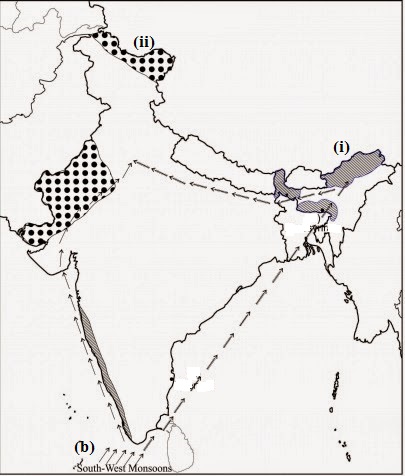NCERT Solution: Climate
Following are the features of the cold season:
→ The winter season begins from mid-November and till February; in northern India.
→ December and January are the coldest months in the northern part of India.
→ The temperature ranges between 10°-15°C in the northern plains, while it ranges between 24°-25°C in Chennai.
→ Days are warm and nights are cold.
→ Frost is common in the north and the higher slopes of the Himalayas experience snowfall.
→ The northeast trade winds prevail over the country in this season. As these winds blow from land to sea, most parts of the country experience a dry season.
→ The weather is usually marked by clear sky, low temperatures and low humidity and weak variable winds.
→ The inflow of the cyclonic disturbances from the west and the northwest is a characteristic feature of the cold weather over the northern plains.
→ These low-pressure systems originate over the Mediterranean Sea and Western Asia and move into India. They cause winter rains over the plains and snowfall in the mountains.
→ The winter rainfall is in small amount but is very important for the rabi crop. This rainfall is locally known as mahawat.
→ The peninsular region does not have a well- defined cold season due to the moderating influence of the sea.
Characteristics of the monsoon rainfall in India:
→ The duration of the monsoon varies from 100 to 120 days from early June to mid- September.
→ Around the time of its arrival, the normal rainfall increase suddenly and continues regularly for several days. This is called the 'burst' of the monsoon.
→ They are distinguished from the pre-monsoon showers because of their increase in rainfall amount and regularity.
→ The monsoon arrives at the southern tip of the Indian Peninsular generally by the first week of June.
→ The rainfall is unevenly distributed across the country.
Effects of the monsoon rainfall in India:
→ Agriculture in India largely depends on Indian monsoons for water. Late, Low or excessive rains have a negative impact on crops.
→ Due to uneven distribution of rainfall across the country, there are few places that are drought prone and few are flood affected.
→ The monsoon provides India with a diverse climatic pattern. Hence, in spite of the presence of great regional variations, it has a unifying influence upon the country and its people.
On an outline map of India, show the following.
(i) Areas receiving rainfall over 400 cm.
(ii) Areas receiving less than 20 cm of rainfall.
(iii) The direction of the south-west monsoon over India.
Answer

1. Besides landforms and drainage, which is the third basic element of the natural environment?
(a) Temperature
(b) Wind
(c) Rainfall
(d) Climate
2. Why do we wear woollen clothes in winter?
(a) To ward off cold
(b) To ward off heat
(c) To remain calm
(d) To remain drenched
3. The sum total of weather conditions and variations over a large area for a long period of time is called
(a) weather
(b) climate
(c) hot weather
(d) cold weather
4. The state of atmosphere over an area at any point of time is known as
(a) weather
(b) climate
(c) heat
(d) cold
5. Why do coastal areas experience less contrast in temperature conditions?
(a) Due to moderating effect of the seas
(b) Due to land mass
(c) Due to heat conditions
(d) Due to none of the above three
6. Which of the following climatic controls is the most important?
(a) Latitude
(b) Altitude
(c) Pressure and wind system
(d) Continentality
7. An apparent force caused by the earth's rotation is called
(a) coriolis force
(b) centrifugal force
(c) centripetal force
(d) jet stream
8. A broad trough of low pressure in equatorial latitudes is known as
(a) coriolis force
(b) ITCZ
(c) jet stream
(d) centripetal force
9. The state of normal rainfall increasing suddenly and continuing constantly for several days is named as
(a) break
(b) burst
(c) mango shower
(d) kaal baishakhi
10. What is a mango shower?
(а) Premonsoon rainfall in Karnataka and Kerala
(b) Rainfall in June to September
(c) Rainfall in winter days
(d) Rainfall caused by western disturbances
Answers :
1. (d) 2. (a) 3. (b) 4. (a) 5. (a)
6. (a) 7. (a) 8. (b) 9. (b) 10. (a)
Hot days and cool night
Mango Showers come in winters
The Deccan Plateau